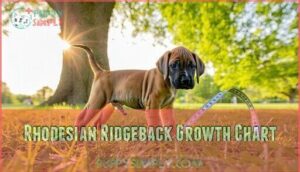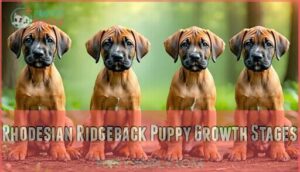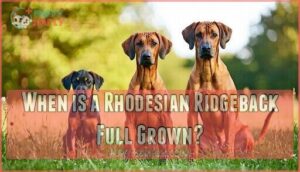This site is supported by our readers. We may earn a commission, at no cost to you, if you purchase through links.
 Your Rhodesian Ridgeback growth chart shows these powerful pups pack on weight quickly during their first year.
Your Rhodesian Ridgeback growth chart shows these powerful pups pack on weight quickly during their first year.
At 8 weeks, they’ll weigh around 12-15 pounds, jumping to 35-45 pounds by 4 months and 50-65 pounds at 6 months.
Males typically reach 80-90 pounds when fully grown, while females settle at 65-75 pounds.
They hit their full height by 12-15 months but continue filling out with muscle until nearly two years old.
Tracking your pup’s progress against these milestones helps you spot potential issues early and adjust their diet accordingly.
The secret lies in understanding the unique factors that influence their development.
The ability to monitor and respond to your pup’s growth is crucial for their overall health, and by doing so, you can ensure they reach their full potential, which is a key part of responsible pet ownership.
Table Of Contents
- Key Takeaways
- Rhodesian Ridgeback Size Comparison
- Rhodesian Ridgeback Puppy Growth Stages
- Rhodesian Ridgeback Size Chart
- Rhodesian Ridgeback Growth Chart
- How Big Do Rhodesian Ridgebacks Get?
- What Do Rhodesian Ridgebacks Look Like?
- Rhodesian Ridgeback Veterinary Costs
- When is a Rhodesian Ridgeback Full Grown?
- Factors That Affect Rhodesian Ridgeback Puppy Growth
- What if My Rhodesian Ridgeback is Not The Right Weight?
- Frequently Asked Questions (FAQs)
- How Often Should I Groom My Rhodesian Ridgeback?
- Are Rhodesian Ridgebacks Prone to Any Specific Health Issues?
- What Type of Exercise Does My Rhodesian Ridgeback Need?
- How Do I Select the Right Pet Insurance for My Rhodesian Ridgeback?
- What Are the Advantages and Disadvantages of Owning a Rhodesian Ridgeback?
- How fast do Rhodesian Ridgebacks grow?
- How much should a Ridgeback weigh at 6 months?
- How big is a 4 month old Ridgeback?
- What age do Rhodesian Ridgebacks calm down?
- How often should I groom my Rhodesian Ridgeback?
- Conclusion
Key Takeaways
- Track your pup’s weight milestones closely – At 8 weeks, they’ll weigh 12-15 pounds, jumping to 35-45 pounds by 4 months and 50-65 pounds at 6 months, with males reaching 80-90 pounds and females 65-75 pounds when fully grown.
- Don’t expect full growth until 18-24 months – Your Ridgeback will hit their full height by 12-15 months but will continue to fill out with muscle until nearly two years old, with growth plates closing around 18 months for females and up to 24 months for males.
- Focus on proper nutrition and moderate exercise during growth – High-quality puppy food with balanced proteins and vitamins fuels healthy development, while avoiding high-impact exercise protects developing joints from damage, such as hip dysplasia.
- Watch for weight red flags and consult your vet when concerned – Whether your pup is underweight from feeding issues or overweight from a lack of activity, professional guidance helps catch health problems early and ensures they reach their full potential.
Rhodesian Ridgeback Size Comparison
When sizing up your Rhodesian Ridgeback against other dogs, you’ll notice they fall into the large breed category with some impressive dimensions.
Gender differences play a significant role in breed size – males typically reach 25-27 inches tall and weigh 85-115 pounds, while females measure 24-26 inches and weigh 70-95 pounds.
That’s roughly the size of a Golden Retriever but with more muscle mass.
Growth variations between individual dogs can be surprising. Your neighbor’s Ridgeback might hit their adult comparison weight months before yours does.
A ridgeback size chart shows these dogs are longer than they’re tall, giving them that distinctive athletic build.
When checking rhodesian ridgeback weight and rhodesian ridgeback height against breed standards, remember that relative size matters more than exact numbers.
A well-proportioned Ridgeback looks balanced, not oversized. Your ridgeback growth chart tracking will show they’re substantial dogs that command respect through presence, not just size alone.
They were originally bred to be lion hunters and guardians.
Rhodesian Ridgeback Puppy Growth Stages
Your Rhodesian Ridgeback puppy’s growth journey happens in distinct stages, each with specific weight and height milestones that help you track their development.
Tracking your Ridgeback’s growth milestones ensures they develop into the strong, healthy companion they’re meant to be.
Understanding these growth phases lets you spot potential issues early and guarantees your pup reaches their full potential as a strong, healthy adult dog, ensuring they become a strong companion.
Rhodesian Ridgeback Puppy is Underweight
When your Ridgeback puppy falls below the typical ridgeback puppy weight range on a puppy growth chart, it’s time to investigate.
Underweight pups often struggle with feeding habits or need a parasite check since worms can steal essential nutrients. A vet examination helps rule out health issues causing growth stunting and guarantees your rhodesian ridgeback weight stays on track.
Monitor your pup’s healthy size weight ratio by adjusting meal portions and exercise levels. Too much activity can burn calories faster than they’re consumed. Remember, some puppies are naturally smaller, but consistent weight loss signals trouble that needs immediate attention.
Rhodesian Ridgebacks also need regular dental care, as they’re prone to dental disease, and this is crucial for maintaining their overall healthy size and preventing issues like dental disease.
Rhodesian Ridgeback Size at 6 Months
By the six-month mark, your Rhodesian Ridgeback puppy has hit a major milestone in their ridgeback growth stages. Your pup’s Six-Month Weight typically ranges from 50 to 60 pounds, with males often reaching 59 to 77 pounds while females stay closer to 50 to 60 pounds. The Expected Height usually measures 20 to 26.5 inches for males, with females slightly shorter.
Growth Variations are completely normal at this stage – some puppies shoot up like weeds while others take their sweet time. Your ridgeback puppy weight represents roughly half their adult size, making this an important checkpoint on your puppy growth chart.
Here’s what makes this stage special:
- Your puppy’s personality really starts shining through their playful antics
- Those adorable oversized paws finally start making sense with their growing frame
- Watching them discover their strength feels like witnessing a gentle giant awakening
Focus on maintaining a consistent Feeding Schedule and meeting their Exercise Needs as they navigate these ridgeback weight by age milestones. Owners should also be aware that dental care matters to prevent future tooth decay.
At What Age Does a Rhodesian Ridgeback Stop Growing?
Most Rhodesian Ridgebacks reach their full size between 18-24 months, though individual variation plays a substantial role in this maturity timeline.
Growth plate closure typically occurs around 18 months for females and up to 24 months for males, marking the end of their ridgeback growth stages.
Several growth cessation factors influence when your pup stops growing.
Genetics determine whether they’ll hit breed standard size on the earlier or later end.
Males generally take longer to fill out their muscular frame compared to females.
You’ll notice ridgeback development milestones slow down after the first year, with ridgeback growth rate decreasing markedly.
Monitor ridgeback weight by age and ridgeback height by age to track progress, but remember – some dogs are just late bloomers who need extra time to reach their full potential.
Rhodesian Ridgeback Size Chart
Understanding your ridgeback’s growth becomes simpler with a clear size chart.
This visual guide helps you track your pup’s ridgeback growth rate against standard milestones, ensuring they’re hitting their genetic potential through proper nutritional needs.
| Age | Male Weight | Female Weight |
|---|---|---|
| 6 months | 52-58 lbs | 46-50 lbs |
| 12 months | 75-85 lbs | 65-75 lbs |
| 18+ months | 85-115 lbs | 70-95 lbs |
Your ridgeback’s ideal weight depends on height and build, with exercise impact playing a key role in healthy development.
The breed’s history includes hunting lions, which reflects their need for physical activity and proper care to reach their full growth rate.
Rhodesian Ridgeback Growth Chart
Tracking your pup’s development becomes easier with a detailed rhodesian ridgeback growth chart.
These growth milestones help you understand what’s normal as your ridgeback puppy growth progresses through each stage.
| Age | Weight (lbs) | Height (inches) |
|---|---|---|
| 2 months | 10-20 | 9-11 |
| 4 months | 40-53 | 17-20 |
| 6 months | 46-58 | 17-19 |
| 12 months | 65-85 | 24-26 |
Weight expectations vary between males and females, with height variations becoming more apparent after six months.
This dog growth chart shows how feeding schedules and exercise impact your puppy’s development trajectory.
How Big Do Rhodesian Ridgebacks Get?
Full-grown Rhodesian Ridgebacks pack impressive size into their athletic frames.
Males typically reach 25-27 inches tall and weigh 85-115 pounds, while females measure 24-26 inches and weigh 70-95 pounds.
These breed standards represent the adult size you can expect, though growth variations occur between individual dogs.
Here’s what influences their final dimensions:
- Genetics – Parents’ size predicts your ridgeback’s adult ridgeback size
- Gender – Males consistently outweigh females by 15-20 pounds
- Nutrition – Quality food supports proper ridgeback growth
- Health – Medical issues can affect weight standards
- Exercise – Activity levels impact muscle development and overall build
What Do Rhodesian Ridgebacks Look Like?
Beyond their impressive size, you’ll instantly recognize a Rhodesian Ridgeback by their most famous feature: the ridge description shows a distinctive strip of hair growing backward along their spine.
This dog breed displays a muscular build with symmetrical outlines and balanced posture that screams athlete.
Their coat colors range from light wheaten to red wheaten, sometimes featuring unique markings like small white patches on the chest.
These breed characteristics and physical traits create a striking appearance that’s both elegant and powerful, making them a breed with a very distinctive look.
Rhodesian Ridgeback Veterinary Costs
Owning a Rhodesian Ridgeback means budgeting for significant veterinary costs throughout your dog’s life. These powerful dogs face specific health risks that require ongoing attention and financial planning.
Your annual vet visits will typically cost $400-$700, covering routine care and preventative medication. However, emergency treatment for conditions like hip dysplasia or dermoid sinus can quickly exceed $1,000. Pet insurance becomes your safety net, with monthly premiums averaging $30-$50 that can reimburse up to 90% of unexpected bills.
Here’s what you’ll spend on essential care:
- Vaccination expenses – $75-$200 annually for core vaccines
- Genetic screenings – $200-$300 yearly for hip and cardiac tests
- Dental care – $300-$800 for professional cleanings
- Emergency treatment – $1,000+ for serious health issues
Smart owners invest in preventative care early, saving money while keeping their Ridgeback healthy long-term.
When is a Rhodesian Ridgeback Full Grown?
Most Rhodesian Ridgebacks reach their full size between 18-24 months, though ridgeback growth expectations vary by gender.
Your pup’s development end comes gradually – they’ll hit adult weight first, then fill out with muscle.
| Growth Milestone | Timeline |
|---|---|
| Height completion | 18-24 months |
| Weight plateau | 12-18 months |
| Muscle development | Up to 24 months |
| Maturity timeline | 18-24 months |
Males typically finish ridgeback size development later than females.
Growth completion depends on genetics, nutrition, and individual factors affecting your ridgeback’s full size potential.
Factors That Affect Rhodesian Ridgeback Puppy Growth
Your Rhodesian Ridgeback puppy’s growth depends on several key factors that you can influence through proper care and attention.
Understanding how genetics, nutrition, and physical health work together will help you support your pup’s development and guarantee they reach their full potential as a strong, healthy adult dog.
Genetics
Most Rhodesian Ridgeback growth patterns trace back to their parents’ DNA blueprint. Your pup’s final size largely depends on genetics, with breed standards providing reliable size predictions. If both parents are on the larger side, expect your puppy to follow suit.
Genetic diversity within the breed means some dogs naturally grow faster or reach different final weights. DNA testing can reveal specific genetic predispositions that influence growth rates and adult size. Ridge inheritance patterns also connect to overall genetic makeup.
Consider these genetic factors:
- Parent size directly influences your puppy’s adult dimensions
- Bloodline history reveals potential growth complications or advantages
- Genetic health screenings prevent growth-stunting conditions
- Championship lineage often produces more predictable size outcomes
Understanding your dog’s genetic background helps set realistic growth expectations.
Nutrition
Throughout your Ridgeback’s growth journey, nutrition serves as the foundation for healthy development.
High-quality puppy food packed with essential proteins, fats, and vitamins fuels rapid growth during those vital first months.
Your pup’s dietary needs will shift as they mature—what works at three months won’t cut it at ten months.
A balanced diet prevents both undernourishment and excess weight gain, which can stress developing joints.
Most puppies need three to four meals daily until six months, then switch to two meals.
Around 12-18 months, you’ll switch from puppy food to adult food.
Weight management becomes critical during this phase.
Consider specialized puppy food for ideal growth.
Proper supplementation should only happen under veterinary guidance, as over-supplementing can actually harm growth.
Remember, good nutrition isn’t just about size—it’s about raising a healthy, happy companion.
Physical Activity & Health
Proper exercise supports healthy growth while protecting developing joints.
Young Ridgebacks need moderate activity—too much high-impact exercise can damage growing bones and increase hip dysplasia or elbow dysplasia risks.
Focus on mental stimulation through training and controlled play. Consider exploring options for puppy agility equipment to keep your puppy active.
Regular vet visits catch any health problems early. Smart weight management prevents joint stress during this critical growth period.
What if My Rhodesian Ridgeback is Not The Right Weight?
Weight concerns with your Ridgeback aren’t something to brush off. If your pup seems underweight despite regular meals, feeding issues might be the culprit—think parasites or poor nutrient absorption.
Don’t ignore weight red flags—your Ridgeback’s health depends on catching problems early before they become serious issues.
Overweight dogs face joint stress that’s particularly hard on this breed’s frame. Exercise impact plays a bigger role than you’d think. Too little activity leads to pudgy pups, while excessive running can stress growing joints.
Finding that sweet spot matters. When your dog’s weight ratio seems off from our charts, don’t play guessing games. A vet consultation helps identify whether you’re dealing with growth abnormalities or simple overfeeding.
Your veterinarian can spot health problems early, from thyroid issues to hip dysplasia. Rhodesian Ridgebacks have strong protective instincts, so consulting a professional can help manage any weight-related behavioral changes.
Remember, maintaining a healthy size isn’t just about looks—it’s about giving your Ridgeback the best shot at a long, active life. Trust your instincts and seek professional guidance when something feels wrong.
Frequently Asked Questions (FAQs)
How Often Should I Groom My Rhodesian Ridgeback?
Unlike high-maintenance breeds, you’ll only need to brush your Ridgeback weekly. Their short coat sheds moderately year-round, so regular brushing removes loose hair and keeps them looking sharp.
Are Rhodesian Ridgebacks Prone to Any Specific Health Issues?
Your Rhodesian Ridgeback faces several health risks you should watch for. Hip and elbow dysplasia are common, along with thyroid issues and cataracts. Regular vet checkups help catch problems early.
What Type of Exercise Does My Rhodesian Ridgeback Need?
Your Ridgeback needs daily moderate exercise like brisk walks, jogging, or hiking.
They’re athletic dogs requiring mental stimulation too.
Avoid high-impact activities during puppyhood to protect developing joints and growth plates, ensuring your dog’s healthy development with daily moderate exercise.
How Do I Select the Right Pet Insurance for My Rhodesian Ridgeback?
Look for coverage including hip dysplasia, elbow dysplasia, and breed-specific conditions.
Compare deductibles, coverage limits, and exclusions.
Choose plans covering hereditary issues since Ridgebacks face joint problems and degenerative conditions throughout their lives, focusing on breed-specific conditions.
What Are the Advantages and Disadvantages of Owning a Rhodesian Ridgeback?
About 85% of Ridgeback owners report strong loyalty bonds with their dogs.
You’ll enjoy their protective nature and athleticism, but they require consistent training and extensive exercise to prevent destructive behaviors from developing.
How fast do Rhodesian Ridgebacks grow?
Your pup will grow incredibly fast during their first year, reaching about 50% of adult weight by four months.
They’ll hit full height around 18-24 months, then continue filling out until age two.
How much should a Ridgeback weigh at 6 months?
Your chunky bundle of energy should tip the scales at 46-58 pounds by six months.
Males typically weigh 52-58 pounds, while females clock in around 46-50 pounds—they’re growing faster than your grocery bill!
How big is a 4 month old Ridgeback?
At four months, you’ll have a growing pup weighing 40-53 pounds and standing 17-20 inches tall.
Your Ridgeback’s legs might look too long for their body—don’t worry, they’re just hitting their awkward teenage phase!
What age do Rhodesian Ridgebacks calm down?
Your Rhodesian Ridgeback will typically start calming down around 2-3 years old when they reach full maturity.
However, individual dogs vary, and proper training, exercise, and mental stimulation help accelerate this settling process substantially.
How often should I groom my Rhodesian Ridgeback?
You’ll need to brush your Ridgeback weekly to keep their short coat healthy and remove loose hair.
During shedding seasons, increase brushing to twice weekly.
Monthly baths are sufficient unless they get dirty, and this routine can help maintain their overall health by keeping their coat healthy.
Conclusion
Watching your Rhodesian Ridgeback transform from a tiny pup to a magnificent adult can feel overwhelming—but you’ve got this.
Your rhodesian ridgeback growth chart serves as your roadmap through those pivotal first two years.
Remember, every dog grows at their own pace, so don’t panic if your pup doesn’t match the numbers exactly, and trust your instincts.
Maintain regular vet checkups, and celebrate each milestone.
You’re raising one of Africa’s most remarkable breeds—enjoy the journey ahead.
- https://www.pawlicy.com/blog/rhodesian-ridgeback-growth-and-weight-chart
- https://iheartdogs.com/male-female-rhodesian-ridgeback-weights-heights-by-age
- https://www.akc.org/dog-breeds/rhodesian-ridgeback
- https://breedatlas.net/rhodesian-ridgeback-growth-chart
- https://articles.hepper.com/how-big-does-a-rhodesian-ridgeback-get












